triple option
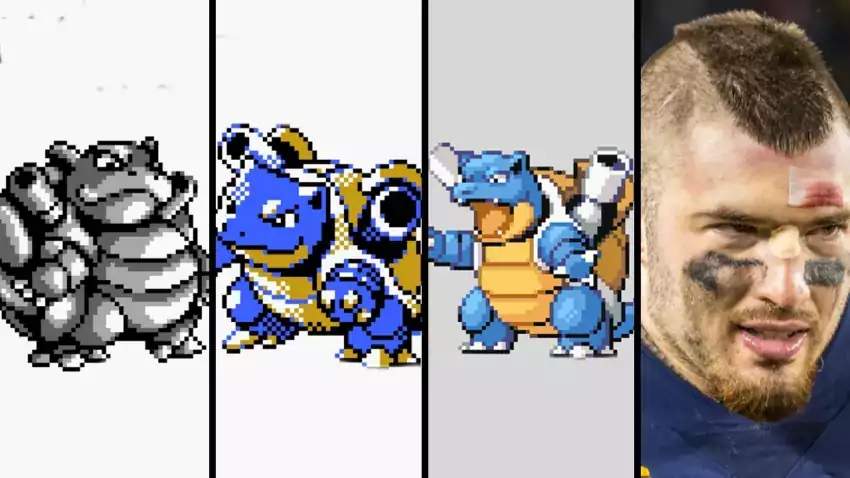
HTTV NOTE: Our kickstarter ends TOMORROW for HTTV. We plan on having at least two live, socially distanced pickup events in August. One at…
 |
Five Shores Brewing up north in Beulah, Michigan. Neck Sharpies/HTTV sponsor Matt Demorest didn't pick the best year to open a brewery, but he did pick the best brewer, and also a location that has lots of outdoor space so you can lawn it this year. If you're in the Traverse area this summer stop in and try it. Watch this space for updates on the pickup events and how those are going to work while keeping the safety of our readers foremost.
-----------------------------------------------
Someone not yet very practiced at the art of explaining things once described to me why Pokemon is so popular. Forgive me if I get any of this wrong but as I understand it you capture a basal creature with some kind of elemental property. Then you train it. After a certain point your creature gains access to more of its baked-in power, and then with more training it reaches a level of maturity where it can use that same basic elemental ability to deal with all situations. To reach its final iteration you have to add some kind of outside element, at which point your Pokemon is a spiky, accoutrement-covered bad-ass.
And I thought that's a lot like how football plays work. You've got your basic play, and as you get better at it you can run it from different looks and adapt it on the fly to whatever the defense is doing to it. #SpeedInSpace is that added item, which one determining the thing's ultimate form.
The offensive gameplan for the Citrus Bowl was really the culmination of a season in which Michigan steadily tweaked and improved their base Pin & Pull running game. One of the ways they did this was to toy with motions, personnel, and formations to create the matchups they desired on the outside. Observe this beauty:
I call it Pin & Pullazord.
There's a LOT going on with this play, too much to unpack with one graphic. I expect you already know how to play Pin & Pull, and its intermediate forms so we can go right to Level 64 and beyond.
[After THE JUMP: add Held Item BenchMasonite]
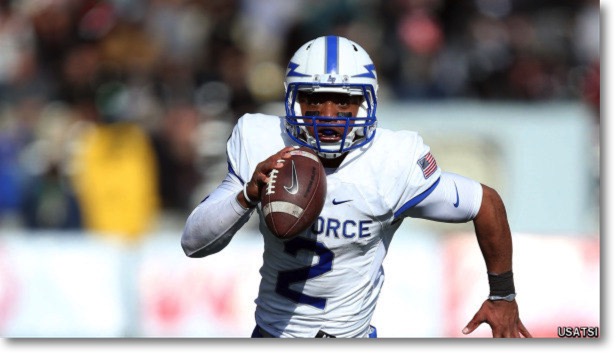
QB Arion Worthman is a dangerous runner.
This is going to be a little different than the usual FFFF posts. Air Force is coming off a bye week; they crushed an overmatched VMI squad 62-0 in the opener; they return only six starters, five on offense and one on defense.
Another program under these circumstances may not even merit a full post, but Air Force is no ordinary program. Their success is based on plugging well-coached upperclassmen into their unusual schemes—a triple-option offense and wildly aggressive defense—to the point that, with a few exceptions, the personnel involved hardly matters.
So, instead of watching Air Force walk all over VMI, I went back to last year's Boise State game to get a feel for their scheme and how it functions against quality competition. AF's two most important offensive players starred in that game, too, so this should still give a decent idea of what Michigan will have to stop on a player-specific level.
Personnel. Seth's diagram [click to embiggen]:
Air Force won't always line up in the flexbone. While head coach Troy Calhoun is very much a part of the Fisher DeBerry coaching tree, he's updated the offense in his 11 seasons at the helm, mostly by incorporating spread principles.
Beyond the two dangermen, don't get too caught up on personnel at the skill positions, as Air Force will rotate a ton. Sixteen different players logged carries against VMI, and six different players accounted for their ten receptions.
Yes, McCray lost his star until he cleans up his issues in space. He'll get a major test in this very game.
The base play. I highly recommend you check out EGD's diary on Air Force's offense, which was a huge help in putting this post together. The base play of their offense is the inside veer, which sets up everything else they'll do. EGD's primer:
Now, AFA is known for running its option plays out of numerous formations (and here is some VIDEO of them doing just that. But in the standard flexbone formation that the triple option is commonly associated with, there are two A-backs who line up just outside the tackles (and may be called “slotbacks” in this formation), while the B-Back aligns two yards directly behind the heels of the quarterback.
Okay, so: the triple option. The base play in the triple option offense is the “inside veer.” That is the core play on which the B-Back threatens the dive (attacking inside the OT), the quarterback threatens off-tackle, and the (an) A-back threatens further outside (the linebackers). Inside veer looks slightly different depending on whether it’s run against a three-man or four-man defensive line, and with Don Brown we really don’t know which one to expect, but for simplicity’s sake let’s just look at it against Brown’s basic 4-2-5:
The A-back (who'll be the pitchman) motions behind the B-back at the snap. The first read is of the defensive lineman to the outside of the playside guard (the circled WDE on this play); if he doesn't attack the diving B-back, the quarterback hands off to the B-back. If the quarterback doesn't give on the dive, his next read is the defender to the outside of his first read (the circled safety, in this case); if that defender goes after the QB, he pitches to the motioning A-back, who will attack the edge. If nobody takes the QB, he keeps it.
Simple enough, right? Now you just have to prepare for them to run it out of a bunch of different formations with several tricky constraint plays, all while making sure not to overcommit to the run and allow a deep bomb in the passing game.
Spread, Pro-Style, or Hybrid? None of the above, really. This is still a flexbone triple-option system at its core, and that doesn't neatly fit into any of those categories. In this video from 2010, you can see them running the triple option out of Maryland I, shotgun two-back (with a shovel pass replacing the fullback dive), and flexbone sets:
Basketball on Grass or MANBALL? Mostly basketball on grass; there's an interesting four-minute coaching clinic video of Calhoun talking about how AF runs inside zone if you're so inclined. (The short version: they want to get upfield in a hurry, so their back has two options, frontside A-gap or backside A-gap.)
Hurry it up or grind it out? You'd expect an old-school triple option team to grind it out, right? Wrong. Air Force is even tougher to defend because they go at light speed; they ranked seventh in the country in adjusted pace in 2016. Just because they keep the clock moving doesn't mean they're moving slow.
[Hit THE JUMP for the rest of the breakdown.]
"Every football team eventually arrives at a lead play: a "Number 1" play, a "bread and butter" play. It is the play that the team knows it must make go, and the one its opponents know they must stop. Continued success with it, of course, makes your Number 1 play, because from that success stems your own team's confidence." –Vince Lombardi
As we discuss coaching candidates we'll invariably get into the same old discussions on what kind of base offense said candidate might want to run. There was some discussion on the board this week and I wanted to expand that discussion into some basic "Rock" plays of various offensive schemes.
It is incorrect to identify any one play (and even more incorrect to identify a specific formation or personnel group) as a complete offense. You always need counters to keep doing the thing you do, and the counters will often borrow directly from some other offensive concept's rock. All offenses will borrow from each other so no breakdown is going to describe more than 60% of any given offense. Most zone blocking offenses throw in man-blocked things (example: inverted veer) to screw with the defense. You can run most of these out of lots of different formations. You can package counters into almost all of them (example: The Borges's Manbubble added a bubble screen to inside manball).
Really what you're describing when you talk about any offense is the thing they do so well that they can do it for 5 or 6 YPP all day long unless defenses do something unsound to stop it (like play man-to-man, or blitz guys out of coverage, etc.). Some examples of offenses and their formation needs (where a need isn't specified, figure they can use any set or formation: spread, tight, 23, ace whatever). I've given the rock plays, and left out the counters and counters to the counters because that gets into way too many variants.
Finally, the terms "pro style" and "spread" are meaningless distinctions. NFL offenses have the luxury of getting super complex: they have passing game coordinators who teach the QBs and WRs Air Raid things then run zone or power blocked things. The spread refers to formations and personnel—it doesn't say anything about whether the QB runs, if it's an option offense, or what tempo it runs at, or even what kind of blocking it uses. What I've done here is break up the offenses into "QB as Run Threat" and "QB Doesn't Have to Run" since the construction of these base plays usually stems from that. Remember, however, that QB running offenses can (and often do) still use blocking right out of Vince Lombardi's favorite play.
QB as Run Threat Offenses:
Triple Option
The FB dive will hit too quickly for anyone but the DE to stop; once the DE bites, the RG moves down to the second level while the QB keeps and heads outside, with the RB in a pitch relationship to defeat the unblocked defender there.
Concept: QB makes a hand-off read then a pitch read.
Makes life especially hard on: Edge defenders who have to string out plays against multiple blockers and maintain discipline.
Formation needs: Two backs.
Helpful skills: QB who can consistently make multiple reads and won't fumble, highly experienced, agile OL, backs who can both run and bock.
Mortal enemy: The Steel Curtain. Stopping the triple option is a team effort; if everybody is capable of defeating blocks, challenging ball-carriers, and swarming to the pitch man there's nowhere to attack.
Examples: Air Force, Nevada, Georgia Tech, Bo's Michigan
[Hit the jump for ZR, QB power, Air Raid, West Coast, Manball, Inside Zone, and the Power Sweep].

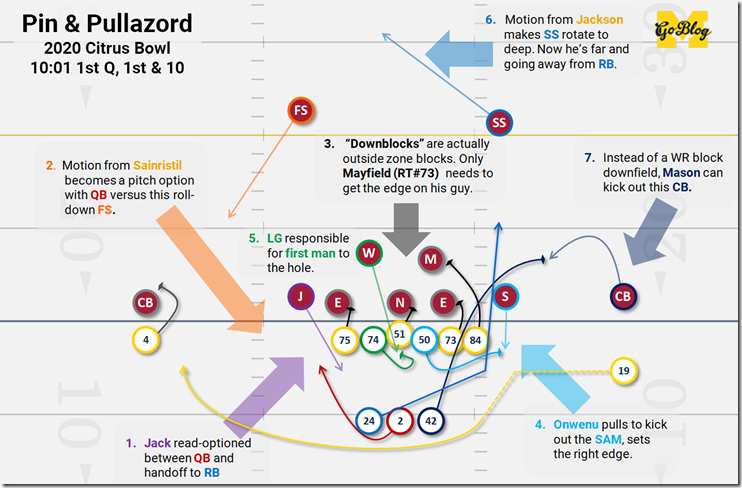
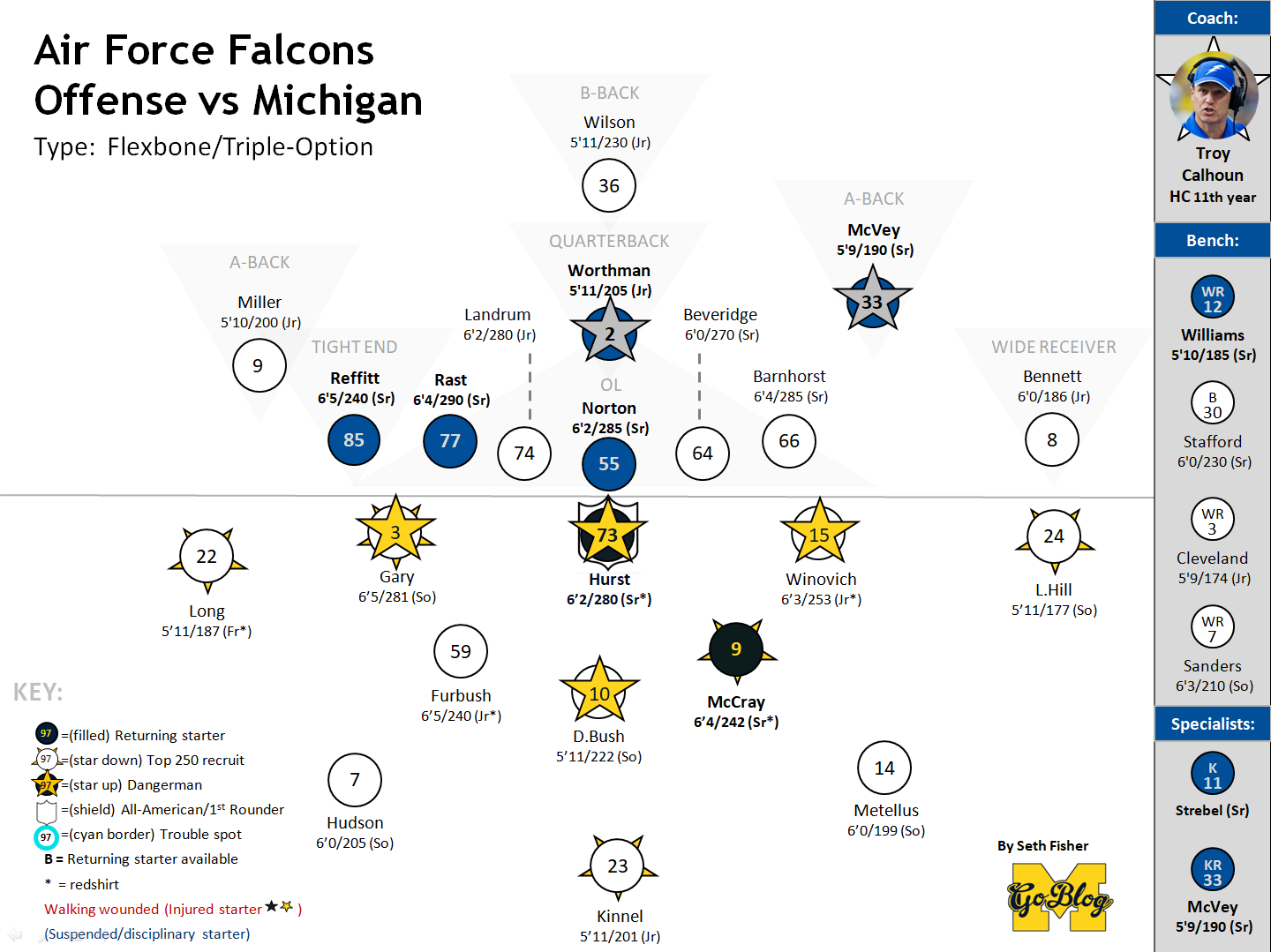


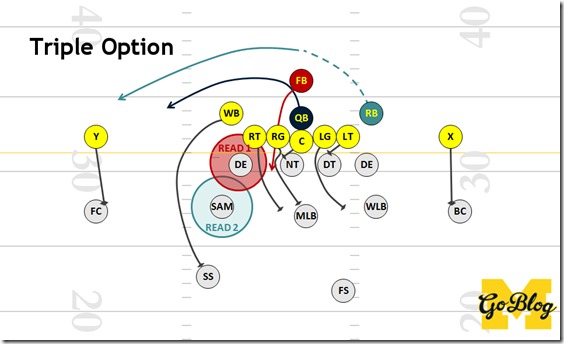
43